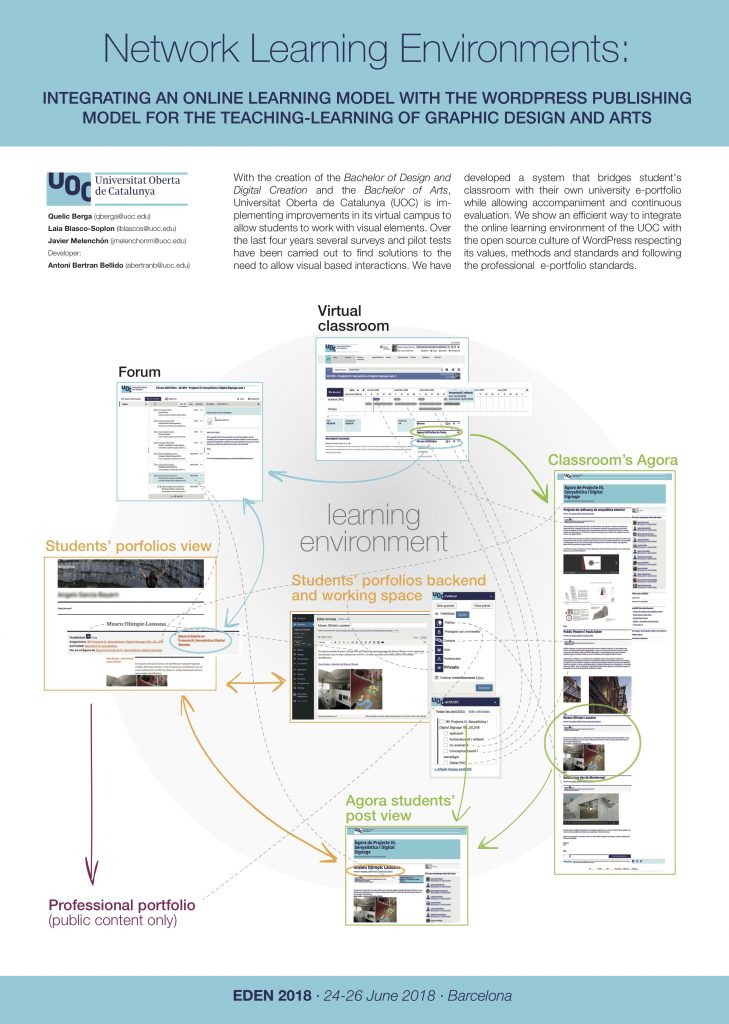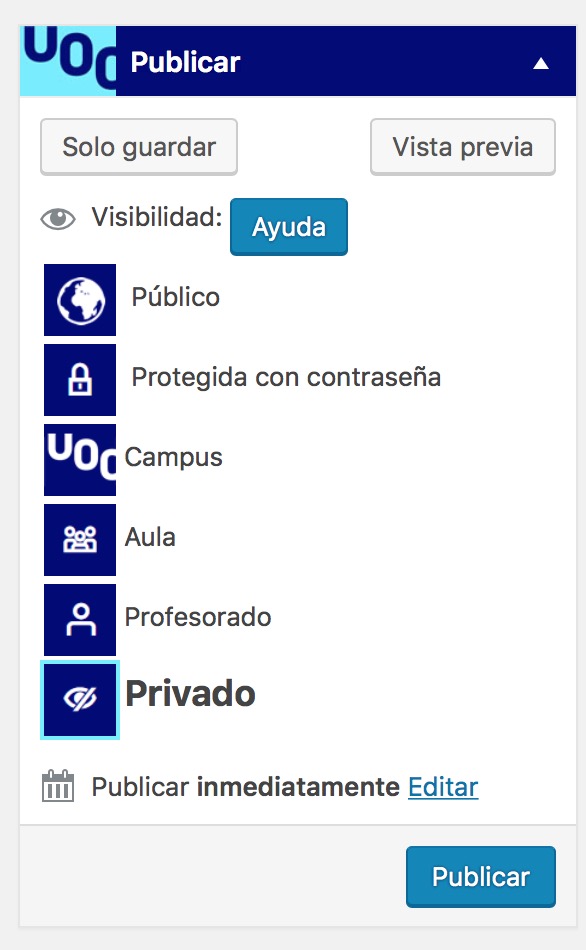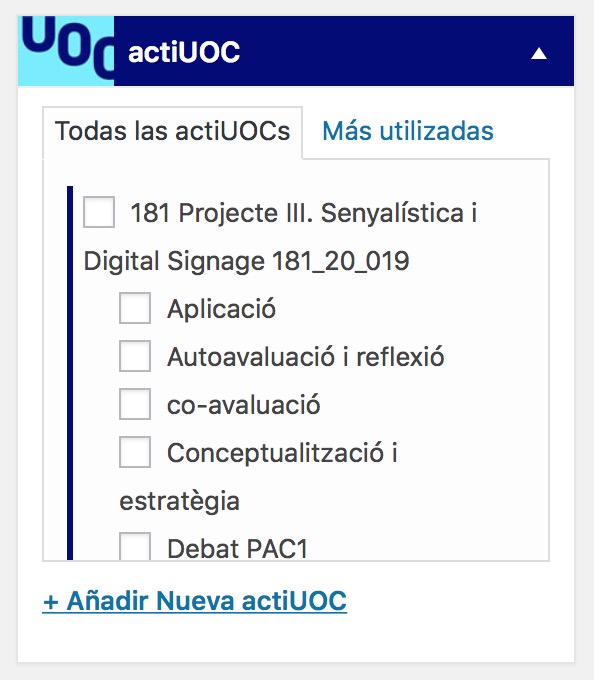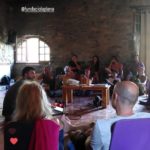Summary
With the creation of the Grau de Disseny i Creació Digitals (Bachelor in Design and Digital creations) and Grau en Arts(Bachelor in Arts), Universitat Oberta de Catalunya (UOC) has started to implement improvements in its virtual campus to allow students to work with visual elements. Several surveys and pilot tests have been carried out over the last four years with the aim of solving the need for students to show their visual creations online. We have developed a system that bridges student's virtual classroom with their personal university e-portfolio, allowing accompaniment and continuous evaluation and at the same time following the professional standards to allow an easy migration towards a professional e-portfolio. We show an efficient way to integrate the online learning environment of the UOC model with the open source culture of WordPress respecting its values, methods and standards.
Authors
Quelic Berga, Antoni Bertan Bellido, Laia Blasco Soplón
Introduction: Students e-portfolios and professional e-portfolios
An e-portfolio is a digitized collection of artifacts including demonstrations, resources, and accomplishments that represent an individual, group, or institution. This collection can be comprised of text-based, graphic, or multimedia elements archived on a Web site or on other electronic media (Lorenzo & Ittelson, 2005). But the full impact of e-portfolios is realized when the author(s) and others reflect on the content (Reese & Levy, 2009). When used in learning environments, its use contributes to the development of students’ transformative capabilities: autonomy, reflexivity, critical thought, creativity and cooperation, amongst others (Pires, 2018).
Student e-portfolios were born out of faculty-assigned, print-based student portfolios dating back to the mid-80s (typically in art-related programs and in disciplines with significant writing components, such as English and communication studies) and gained prominence in higher education during the mid-90s. In the printed mode, as well as in today’s electronic mode, students basically collected their work, selected examples to showcase, and reflected on what they learned (Lorenzo & Ittelson, 2005).
In visual arts context, there is an extensive tradition of professional portfolios. These are tools for documentation, dissemination and socialization of the main projects of a study or an author and serve to demonstrate the capabilities of professional development and implementation. What is lacking is research that provides insights into how a portfolio for learning can be used in Higher Education to develop understanding into one’s own learning, assessment and professional practices (Klenowski, 2006).
This project is being tested in the Universitat Oberta de Catalunya (UOC) environment (Sangrà, 2002), a fully online university. UOChas a student centered pedagogical model that ensures a guided learning path through the use of curated resources, according to the experience of a team composed by instructional designers, usability experts and, of course, teachers. In the e-learning context, constant teaching presence is essential in both group and classroom spaces, where online teachers constantly monitors each group and constantly communicate with them, designing, facilitating and promoting educational experience (Garrison, Anderson, & Archer, 2001).
Context and background
The Grau de Disseny i Creació Digitals (Bachelor in Design and Digital creations) was conceived between 2014 and 2015 and opened to the students during 2016. The Grau en Arts(Bachelor in Arts) followed the same development, starting the process one year later and opening in 2017.
Both degrees need technological solutions to share, discuss and organize students visual and graphical outcomes, While the UOC already has experience dealing with this type of graphical evidences through the Grau de Multimedia since 1999, it still has no tools or systematized methodologies for the submission, publication and evaluation of visual and graphical content done by students. Consequently, the university considers the use of a model of student e-portfolio (Lorenzo & Ittelson, 2005) to solve this need.
DesignIt conceptualization and MyDocumenta case study
In 2015, the company DesignIt, specialized in user experience, was hired to conduct a research and to collect the core needs. They presented several documents and a proposal of a wireframe. During the first semester of 2017, an adapted version of MyDocumenta tool (MyDocumenta, 2018) took over and an adaptation of the original tool was forked to adapt to the core needs. This process was analyzed later, giving two clear results: there is a real need for e-portfolio tools in both degrees, and the given tool was not fulfilling the aims for the e-portfolio because it did not follow samesly the university learning model, nor the professional ways of doing e-portfolios.
Table 1: Detected needs during DesingIt conceptualization and MyDocumenta pilot tests.
UOCFolio: a WordPress e-portfolio adapted for the Online Teaching-Learning Environment.
Once reached those conclusions and needs, taking in consideration our expertise in interface design and in online teaching, we made a proposal in which instead of developing a new tool or method from scratch, it was possible to connect two existing models that have proven their success. On the one hand, the distance learning model of the UOC, and on the other, the content management system (CMS) WordPress. WordPress was chosen for its wide use on the web (Built with, 2018) as well as for its popular use by professional designers and artists.

Plugins to integrate two models
Instead of modifying the UOC learning model or modifying the WordPress core system by altering its main code, we opted for the concept of designing connectors that use the OpenAPI of the UOC and are integrated non-invasively into the WordPress workflow. To do so, we are launching a pilot test of Students WordPress e-portfolios that are integrated into the UOC learning environment.
For the project, we decided to use a MultiWordPress install so the maintenance of the whole system can be done in a centralized way. On the other hand, we have develop a system to authenticate students with their UOC campus login to have all the data synchronized. In this way, each student has their own WordPress connected with their profile and activity in the university.
NetUOC plugin
One of the main challenges was to effectively combine the different work spaces within the student’s personal e-portfolio. A publication system has been designed to allow six levels of granularity when publishing the work: Private, Visible to teaching staff, Visible in the agora of the classroom, Visible to the UOC community, Only visible with password and Public. This system allows the student to decide if it is a personal work space, if it is a shared space with the teaching staff, the virtual classroom, the campus or the public on the internet. (see Figure 1)

Figure 1. NetUOC plugin substitutes the standar WP publishing box to allow for the UOC publication granularity.
ActiUOC plugin
At UOC,each classroom has a timeline and several activities to follow-up along the semester. A connector that follows both, the WordPress category model and the continuous assessment system of the UOC, has been developed to link both models. As seen in Figure 2, a box with a list of activities per classroom in which the student is enrolled is automatically created. The student is asked to tag their related outcomes with the right activity category for later assessment and correct sharing.

Figure 2. ActiUOC allows students to assign their actual ongoing assignments to their e-portfolio posts. The look and feel respects and follows the category system by WordPress.
AGORA blog
The classrooms Agora is an automatically generated blog, accessible from a link found in the virtual classroom, that gathers all the works of the classmates in a unique space. Like an exhibition space, it is also facilitating discussions around those course activities. Each time a student publishes a content tagged as an activity associated to the course, and only if it is defined as visible, at least, for the classmates it appears automatically to that blog.
It should be noted that these Agoras only show all their content if the visitor belongs to the right classroom. Still, tutors, staff and students, by assigning more open view permissions using the netUOC plugin, can set-up virtual shows for the colleagues of the campus or public views of the work done during the course for the general audience.
ForumLink plugin
After what was learned during the MyDocumenta pilot, it was decided not to decentralize debate spaces and prioritize the UOC model over other ways of giving feedback. ForumLink allows classroom members to open debate threads or follow them in case they have already been opened in relation to contents published in students’ portfolios inside the forum space of the virtual classroom. Instead of opening a teaching debate in the student’s space, we keep the conversation in the forums of the classroom where other colleagues can learn from the debate and participate, while keeping the WordPress possibility of making comments as a visitor in the posts.
Results
Taking into account the importance and usefulness of the professional artistic e-portfolio in the areas of design and art, one of the skills that students must have is the ability to build their own e-portfolio. Learning and becoming familiar with the WordPress environment, that follows the open web standards and shows a huge flexibility to adapt to each user, becomes part of the learning process of the students.
Moreover, in a e-learning environment, it is essential that teachers have access to the artworks generated by the student, together with the ability to assess and evaluate these evidences throughout the course. It is also relevant that students access their classmates outcomes to learn, discuss, engage and comment on the work of others. This is achieved by using the ForumLink plugin allows to debate about the outcomes in the classroom and by automatically sharing all the visual content with the classmates thanks to the Agora system.
With the aim to keep both models independent but unite, a series of connectors are implemented that, visually, create a bridge between the design of the university and that of the WordPress platform. Both the technical treatment and the design have been developed with the intention of clearly defining this symbiotic relationship.
Finally, the objective is to consider the value of both working models. On the one hand, maintain and enhance the learning model based on the accompaniment and flexibility that asynchronism and ubiquitous access suppose. On the other hand, implement solutions that respect the open source model and follow the WordPresscodex (WordPress, 2018), taking advantage of and also putting in value the popularity and professional use of the tool. As a university we also take in consideration its capacity to empower decentralization, freedom and autonomy of its users, as well as the enormous capacity for growth and adaptation based on the use of non-centralized by a market plugins.
Therefore, we conclude that in online artistic studies it is important to have technological tools throughout the training program that help students build their own artistic portfolio while discussing the outcomes with classmates and teachers. The seamless integration between both, the campus and the e-portfolio, is essential for the creation of the proper learning environment, and the future ability of the students to create their own professional portfolio.
References
Anderson, T., Liam, R., Garrison, D. R., & Archer, W. (2001). Assessing teaching presence in a computer conferencing context.
Builtwith main webpage (2018) Retrieved from https://trends.builtwith.com/cms
Klenowski, V., Askew, S., & Carnell, E. (2006). Portfolios for learning, assessment and professional development in higher education. Assessment & Evaluation in Higher Education, 31(3), 267-286.
Lorenzo, G., & Ittelson, J. (2005). An overview of e-portfolios. Educause learning initiative, 1(1), 1-27.
MyDocumenta main webpage (2018) Retrieved from http://www.mydocumenta.com/
Pires, A. L. D. O., Rodrigues, M. D. R., & Pessoa, A. M. (2018). Transforming pedagogy in higher education. HAMK Unlimited Journal, 1-11.
Reese, M., & Levy, R. (2009). Assessing the future: E-portfolio trends, uses, and options in higher education.
Sangrà, A. (2002). A new learning model for the information and knowledge society: The case of the Universitat Oberta de Catalunya (UOC), Spain. International Review of Research In Open And Distance Learning, 2(2). Retrieved from http://www.irrodl.org/index.php/irrodl/article/view/55
Universitat Oberta de Catalunya. Conoce la UOC, hechos y cifras. In the UOC webpage (online) [accessed on July 9, 2018]http://www.uoc.edu/portal/es/universitat/coneix/fets-xifres/index.html
WordPress codex webpage (2018) Retrieved from https://codex.wordpress.org/

 Català
Català Español
Español




Comments by admin